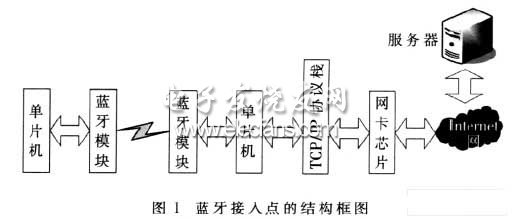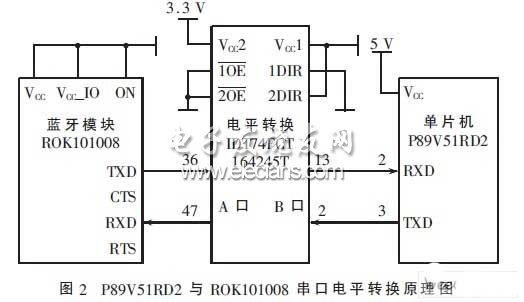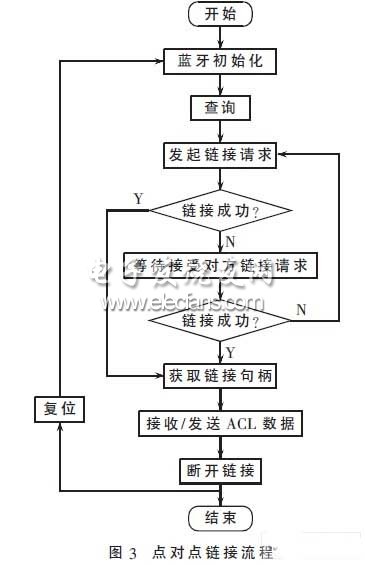Using 51 single chip microcomputer P89V51RD2 as the main controller, ROK101008 as the Bluetooth module, W3100A as the TCP / IP hardware protocol stack, and Ethernet network card chip RTL8201 as the network interface, the hardware structure and software flow of a Bluetooth-based wireless access point are introduced. The design supports TCP / IP protocol and Bluetooth protocol, has the wireless Internet access function of Bluetooth devices, and realizes the remote transmission of data through the Internet. The wireless access technology is a network communication technology that realizes the wireless network accessing the wired network, and its typical application is a wireless access point. A wireless access point is a device that connects a wireless network and a wired network to enable wireless clients and wired networks to send and receive data to each other. It is a network interface for wireless mobile terminal devices to access the Internet. Wireless mobile terminals can access Internet resources through wireless access points. A Bluetooth-based wireless access point is a network interface that enables a Bluetooth wireless mobile terminal to access the Internet. Its main function is to enable a Bluetooth device to access the Internet through Bluetooth wireless transmission technology and realize wireless Internet access for one or several Bluetooth devices. 1 Composition of Bluetooth access point The block diagram of the Bluetooth access point is shown in Figure 1. It consists of two parts: front-end and back-end. The front-end part is composed of a Bluetooth module and a single-chip computer, which constitutes a Bluetooth transmission / reception module. Its main function is to establish a wireless link with other Bluetooth devices through the Bluetooth protocol to achieve wireless communication between Bluetooth devices. The terminal is composed of a single chip microcomputer, TCP / IP protocol stack chip, and Ethernet network card chip, which constitutes a single chip network interface module. The main function is to access the Internet via RJ45 via TCP / IP protocol stack chip and network card chip, according to the TCP / IP protocol , Communicate with the server on the Internet to realize the remote transmission of data. In this way, the Bluetooth access point can be accessed from the Bluetooth network to the Internet network, and the conversion between the Bluetooth protocol and the TCP / IP protocol is completed. The Bluetooth access point provides wireless Internet access for other Bluetooth devices. As can be seen from Figure 1, the design of the Bluetooth access point includes the design of the Bluetooth receiving / transmitting module and the design of the single-chip network interface module. Each module includes two parts: hardware design and software design. 2.1 Bluetooth transceiver module design 2.1.1 Hardware design The Bluetooth receiving / transmitting module is mainly formed by the single-chip computer connecting with the Bluetooth module through the asynchronous serial communication interface. Since the working voltage of the single chip and the Bluetooth module are not necessarily the same, not only the power conversion problem but also the logic level conversion problem needs to be considered. If the selected MCU and Bluetooth module are powered by +3.3 V, the UART serial port of the MCU can be directly connected to the UART serial port of the Bluetooth module. In this design, the selected single-chip microcomputer P89V51RD2 is +5 V power supply, ROK101008 is +3.3 V power supply, power conversion is required. The power conversion circuit is relatively simple, just use the power conversion chip AMS1117-3.3. As for the logic level conversion, the level conversion chip IDT74FCT164245T of IDT can be accessed between P89V51RD2 and ROK101008. The connection diagram is shown in Figure 2. The software design of the Bluetooth transceiver module includes two parts: Bluetooth link and data transceiver. The communication between Bluetooth devices is mainly realized by sending HCI commands to the Bluetooth module and receiving HCI events through the microcontroller. When the two Bluetooth modules are successfully linked, you can receive / send data in accordance with the ACL packet format specified by the Bluetooth specification. This system designs a Bluetooth terminal point-to-point link, and its communication process is shown in Figure 3. It can be seen from the figure that the Bluetooth communication process mainly includes the initialization, inquiry, link, data communication and link disconnection of the Bluetooth module. During implementation, Bluetooth commands can be packaged into a HCI command interface function library in the form of functions. When writing the HCI driver, you can directly call the HCI instruction function from the function library to perform basic operations on the Bluetooth device, such as resetting the Bluetooth device, reading the Bluetooth device address, initializing, querying, establishing a link, sending and receiving data, and disconnecting Links etc.
Wifi Antenna Description
Wi-Fi wireless networking works by sending radio transmissions on specific frequencies where listening devices can receive them. The necessary radio transmitters and receivers are built into Wi-Fi enabled equipment like routers, laptops, and phones. Antennas are key components of these radio communication systems, picking up incoming signals or radiating outgoing Wi-Fi signals. Some Wi-Fi antennas, particularly on routers, may be mounted externally, while others are embedded inside the device's hardware enclosure.
WIFI Antenna (2.4G Antenna) is one kind of wireless antennas.The main operating frequency of WLAN is 2.4Ghz and 5.8Ghz.
WiFi antenna(WLAN antenna)is installed on wireless devices like WLAN AP to reinforce signal strength.Wireless device will radiate signal in air at specified frequency 2.4Ghz or 5.8Ghz through WiFi antenna/WLAN antennas and allow other WLAN devices like NB or smartphone to get signal at same frequency range.
WLAN or WiFi is based on IEEE 802.11a,802.11b,802.11g,802.11n standards.WLAN or WiFi provides a connection through a WLAN AP,and this technology allows people can be connected to the networks within a coverage area.
WiFi Antenna specifications
Frequency range: 2400-2500Mhz
Connector : SMA
Picture Show
WIFI Antenna Wifi Antenna,LTE WiFi Antenna,Omni GSM Wifi Antenna,Gain Rubber WIFI Antenna Shenzhen Yetnorson Technology Co., Ltd. , http://www.yetnorson.com
2 Design of Bluetooth access point 
2.1.2 Software design 
V.S.W.R : ≤1.5
Gain-dBi : 7
Polarization : Vertical
Impedance-Ω : 50
Max. Input Power-W : 50
